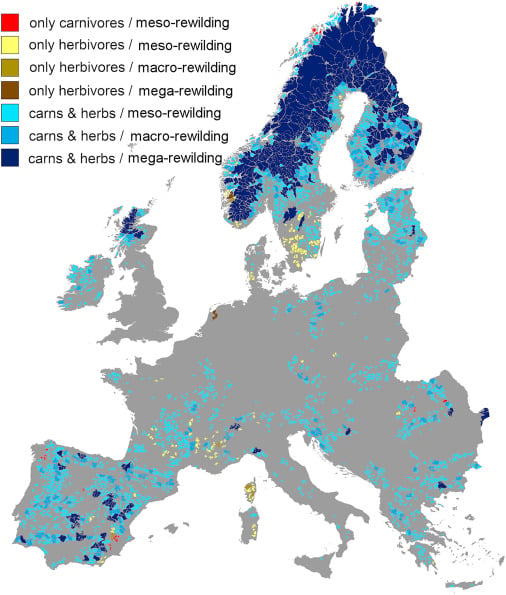A quarter of the European continent, 117 million hectares, is compatible for rewilding, according to researchers writing in the Cell Press journal Current Biology. They provide a roadmap for countries to meet the 2030 European Biodiversity Strategy’s goals to protect 30 per cent of land, with 10 per cent of those areas strictly under conservation.
Rewilding aims to address biodiversity loss by restoring trophic interactions and fostering self-regulating ecosystems. Although gaining traction in Europe and North America, the extent to which rewilding can meet post-2020 protected-area targets remains uncertain.
The team found that 70 per cent of the rewilding opportunities in Europe lie in colder northern climates. Scandinavia, Scotland, the Baltic states and several highland regions in the Iberian Peninsula show the greatest potential.
The research was carried out by Miguel B. Araújo of the National Museum of Natural Sciences, Spain, and the University of Évora, Portugal, and Diogo Alagador, Rui Nabeiro Biodiversity Chair, at the Mediterranean Institute for Agriculture, Environment and Development, University of Évora.
Araújo said, “There are many areas in Europe that have a low enough human footprint, as well as the presence of key animal species, to potentially be rewilded. We also highlight the need for different strategies depending on the conditions of each region.”
The researchers established criteria to determine areas with rewilding potentials: extensive tracts of land, covering more than 10,000 hectares, with little human disturbance that feature vital species. Based on the size of the land and the types of animals that inhabit the area, they further identified two strategies for rewilding, passive and active.
Passive rewilding relies on natural recolonisation, where animals gradually move back into abandoned areas on their own. The approach works best in regions with a healthy population of key herbivores, such as deer, ibex, moose, and rabbits, as well as carnivores, such as wolves, bears, and lynxes.
Regions without key herbivore or carnivore species would require active rewilding by reintroducing the missing species to kickstart the ecosystem’s recovery.
Both strategies aim to create a self-sustaining, biodiverse landscape.

The researchers concluded that, “Nearly 25% of the continent holds potential for rewilding. A great proportion of this area (76 per cent) lies within Scandinavia, Scotland, and the Iberian Peninsula. These areas not only boast the most expansive rewilding potential but they also are where the mega-rewilding ecosystems consisting of extensive uninterrupted patches with minimal human interference coincide with the occurrence of key herbivore and carnivore/omnivore populations.”
Araújo said, “I often refer to herbivores as the ecosystem engineers as they graze and shape the vegetation, while predators would be the architects creating ‘fear landscapes’ that herbivores avoid. The interaction between herbivores and carnivores creates mosaic patterns in the landscapes, essential for biodiversity.”
Some countries, including the United Kingdom, France, Spain and Scandinavian nations, are positioned to reach their conservation goals if they adopt the study’s suggested rewilding zones and strategies. However, given that Europe is densely populated with humans, other countries wouldn’t meet their conservation aims if they relied solely on the study’s recommendations, highlighting the need for alternative conservation approaches. These countries include Ireland, Italy, Belgium, the Netherlands, and Denmark.
Araújo said, “Conservation strategies involving ecological restoration of densely populated areas could help some countries reach conservation goals. Countries could reclaim land to turn it into conservation areas or establish networks of small, protected habitats. Traditional multi-use landscapes, like the oak parklands in the Iberian Peninsula and various extensive agricultural and forestry systems across Europe, could also help if managed sustainably.”
As governments and organisations continue to invest in land conservation, the researchers hope their findings and framework will help these efforts to acquire or manage areas with the greatest potential for successful rewilding. However, despite the prospects, the researchers caution that time is of the essence.
Read the research, Expanding European protected areas through rewilding
